

What I'm gonna do today is give you a play by play of me taking a page of a comic book script and plotting it out into a comic book page.
Me personally, I pretty much never write scripts, because I pretty much always draw my own work. So my "script" is a page of notes of what the important dialogue is and some scribbles of what I have in mind of the important visuals. Sometimes there aren't even words...because...I know what they're gonna say, it's my story.
A "script" of mine is usually something like this...

That ends up turning into something like this...

When I get an actual script from someone, to see if I want to illustrate a project, I'm basically looking for two things. 1- is it going to be fun to draw 2- is it going to be a challenge. If it doesn't have both of those things, I say "no thank you". Both of those are different for me than maybe most people. For example, something like this would be a "no thank you" -page 12- Splash page(that's were one image takes up the entire page) "Hero punches villain into a parked car".
That is neither fun nor a challenge. Aside from maybe changing the camera angle, if you had 12 different illustrators draw that page, there'd be nary a difference between them to the general public unless they each had some dramatically wild style. Even then...the means of displaying that visual information is going to be pretty much the same.
So, when Andy Brown gave me a script to look at for "From Under The Floorboards" written by Baden James Mellonie, I looked for fun and for challenge.
Plug alert! here's were you can get all the info on how to get a copy
https://www.berserkerart.com/?page_id=15106
I read through it and said "yep"! I asked how much leeway I'd have with the conversion from words to pictures. Most scripts you get have visual commands like "viewed from above" or a specific description of how to show the visuals...which....really isn't how it's supposed to work. The writer is the writer and the illustrator is the director. How to move the readers eye around, get the reader to notice things, get a certain reaction from the reader through visuals, and even how many panels to use to convey an idea, that is an entirely different skill set than writing is. If the person in charge of the project has a different (wrong) policy, I politely say "no thank you". Andy said "Do your thing, change the visuals or panels however you like, as long as you get the point across".
Hell yeah, then. Let's do this.
So here's page one of the script...uhm...well, first thing I do when turning a script into a comic book page is scribble on it as I read. Sort of jotting down what's in my head visually as I read/figure out how to convert it.
( You want a piece of advice, all you potential artists/illustrators out there? SKETCH while you think. Don't split it up into two things...as in imagining an image and then trying to draw it. Sketch and imagine at the same time. Train your imagination and hand to work simultaneously. )

Step one is deciding "what IS the point". What is the purpose of this page on it's own and as part of the story. The point here is to show what kind of guy he is/the environment he survives in, and the tension of what he may or may not have heard.
Step two... finding any problems to solve. This script has a common "problem" that drives me nuts. "the man stops"...STOPS. When you're writing a story, it seems like the most natural thing in the world for someone to "stop", but in terms of conveying that with a series of static images...it's nigh impossible, unless you have some overly cartoony scene going on with speed lines and then a panel with no such lines and a "screech" sound effect. Or maybe have the moving person or object hits something and is stopped, and you can show an impact causing the stop. But concepts like- stops suddenly- or - comes to a halt- or any of that...maddenig to try to convey on a comic book page.
It's like...how the hell do writers think we're supposed to pull that off?! I am ranting about this and it's currently directed at myself, because I have a "car comes to a slow stop" in MY OWN current story that I myself wrote. I.E. I do the same thing to MYSELF...all the time...even though I know it can't be done.
Okay, problem two, the concept of- he thinks he heard something. How the...sigh... You can either have a sound effect or not have a sound effect. How in the blue hell do you convey the idea that he thinks he heard something?!
Believe it or not...these two "problems" made me even more interested in illustrating the script.. It's a good story, if the illustrator can solve these "problems" it'll stay a good story...Baden did his job, someone else now has to do theirs. I'm either one of the best, or I am not...so let's figure out a way.
Problem three- is more of a "know yourself" type situation. I have a specific style and skill set. a lot of the visual information James gives...I'm simply not good enough to do much with that. Bernie Wrightson or John Buscema could do a hell of a job showing a face that was weather beaten and rugged and so forth. You'd almost be able to feel the leathery skin and wrinkles.
Me, with my skillset, I could either make him look somewhat grizzled or try too hard and have him look like a crazy old wizard. The more I'd lean into the weathered look on a face, the more comical or pathetic or sinister he'd look, instead of rugged and tough. So...in a "first do no harm" mindset, what I am unable to do in details and texture, I am going to make up for in getting that point across with the visual story itself.
Right off, knowing that we want tension...I'm changing the visuals of the cabin he is walking towards and putting them last, as well as not having any smoke coming out of the chimney. For the sake of tension, we want him alone, isolated. A cabin in walking distance in the initial shot makes him less isolated and smoke coming out of the chimney might imply someone else is already there. Aside from the tension, showing him alone in the woods makes him seem more rugged and formidable.
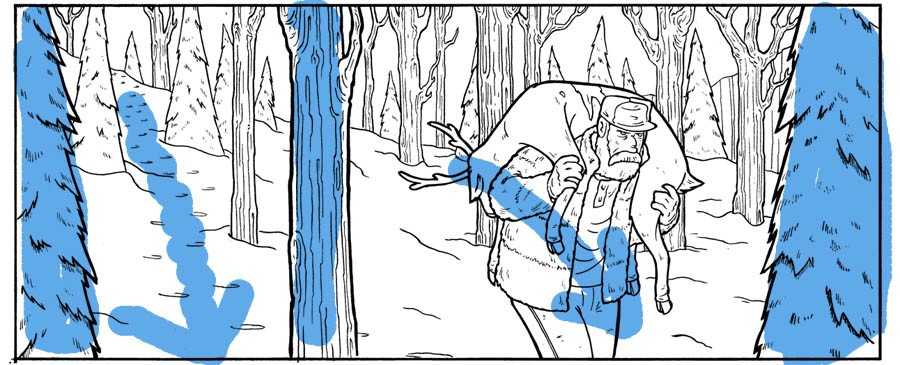
Visually, I set the panel up in sort of a "golden ratio" with two large trees in the left foreground sort of creating a panel of their own, and the big pine tree on the right keeping the eye from trailing off the page. The tracks in the snow are headed down to the next tier of panels as does his body movement (his body movement and posture will have a relationship with the panel directly below...I'll get to that later)
The next tier is the "he thinks he hears something" dilemma" . Which I think I worked out pretty well...

First panel, a rather standard camera shot. His face is calm and fairly expressionless. It is over the top ordinary, in order to add as much impact as possible to the transition to the next panel ( visual side note- The implied line of the deer and his posture lead the eye into the middle panel).
panel 2- Jarring (hopefully) close up of his face looking to the side, with the ear being the center focus of the composition, which theoretically will plant in the readers mind that he hears something. The next panel has him looking over his shoulder (visually he is leading the readers eye back to that middle panel).
The tier below this one benefits from all of that...

A long distance shot, far wider panel than the one previous conveys a bit more time is elapsing. Instead of several panels of him looking to see what is around him, we accomplish the same effect by being able to see what is around him and that he himself is taking it all in. That last panel on the right, very similar posture to the panel directly above which helps convey the movement of him resetting the deer carcass to continue his journey.
Only after that tension has passed do we see him coming up towards the cabin...
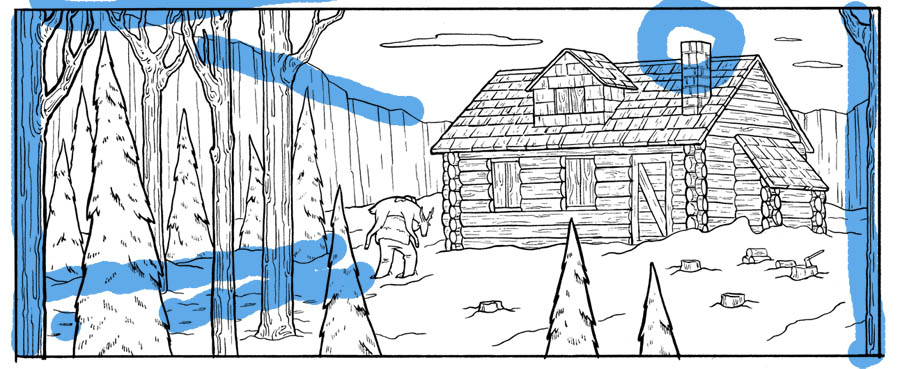
Not much trickery needed in this last panel...some implied lines visually lead the readers eye/adding to the momentum of his march towards the cabin. The script also called for a shed, but it's not needed for any later outcome and there's only so much you can competently fit into a panel without it being a visual mess. I decided that the edge of the woods he was walking out of added more to the scene than a shed next to the cabin. But...that's just my own choice. For sheer pragmatic story telling purposes, it could have gone either way, but as far as giving the page as a whole a visual unity, the woods worked better...so that's the choice I made.
below is the full page and it's got a unique compositional effect, that I like to try to pull off on pages with not much action going on. That being, that you could read it top to bottom, from either side and still get the same general idea. Go to the far right or far left and read straight down, and it still makes sense/ gives you a story.
Just a little technique I try to work in when possible because it give the page as a whole a lot of unity.
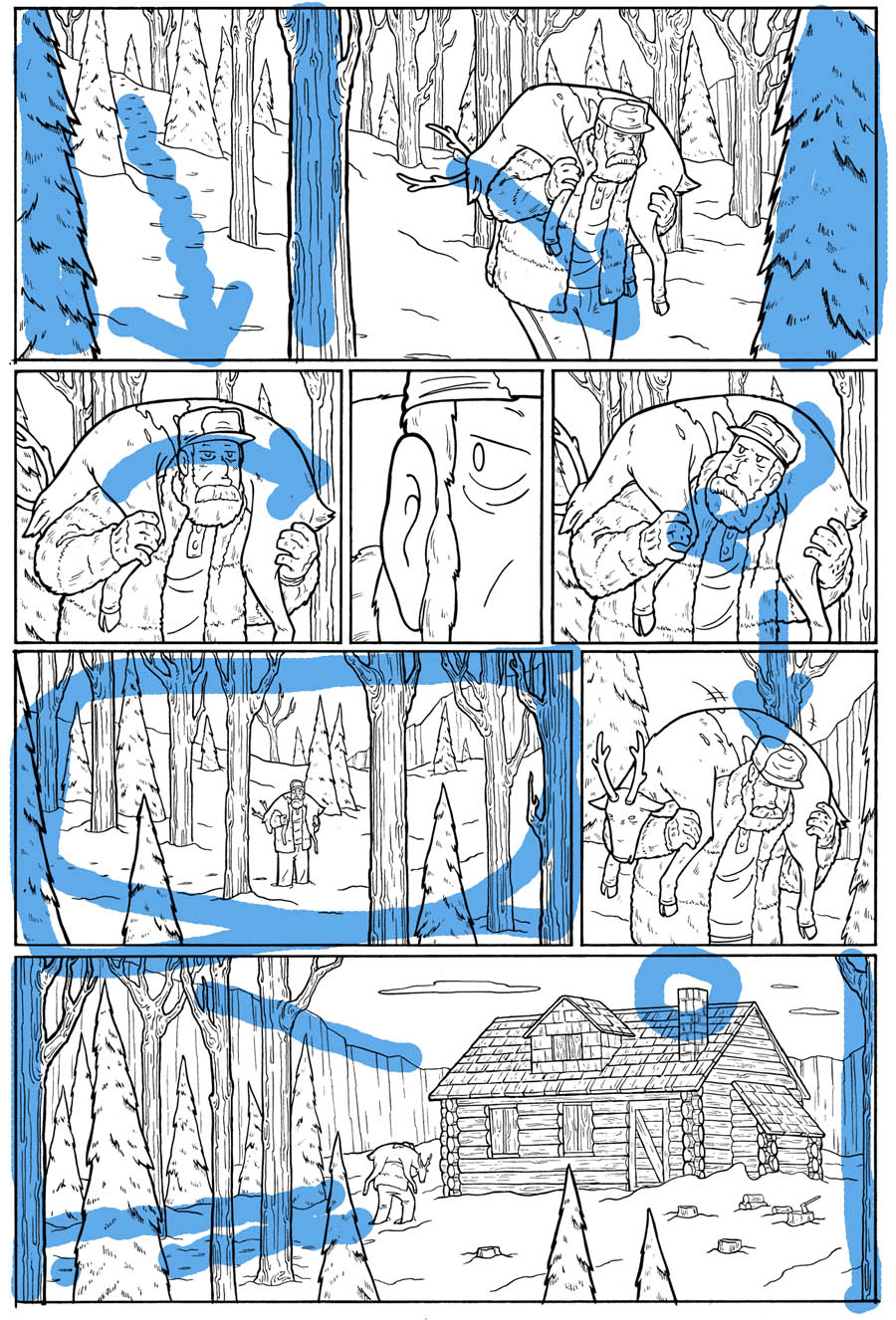
Here it is without the blue scribbles...
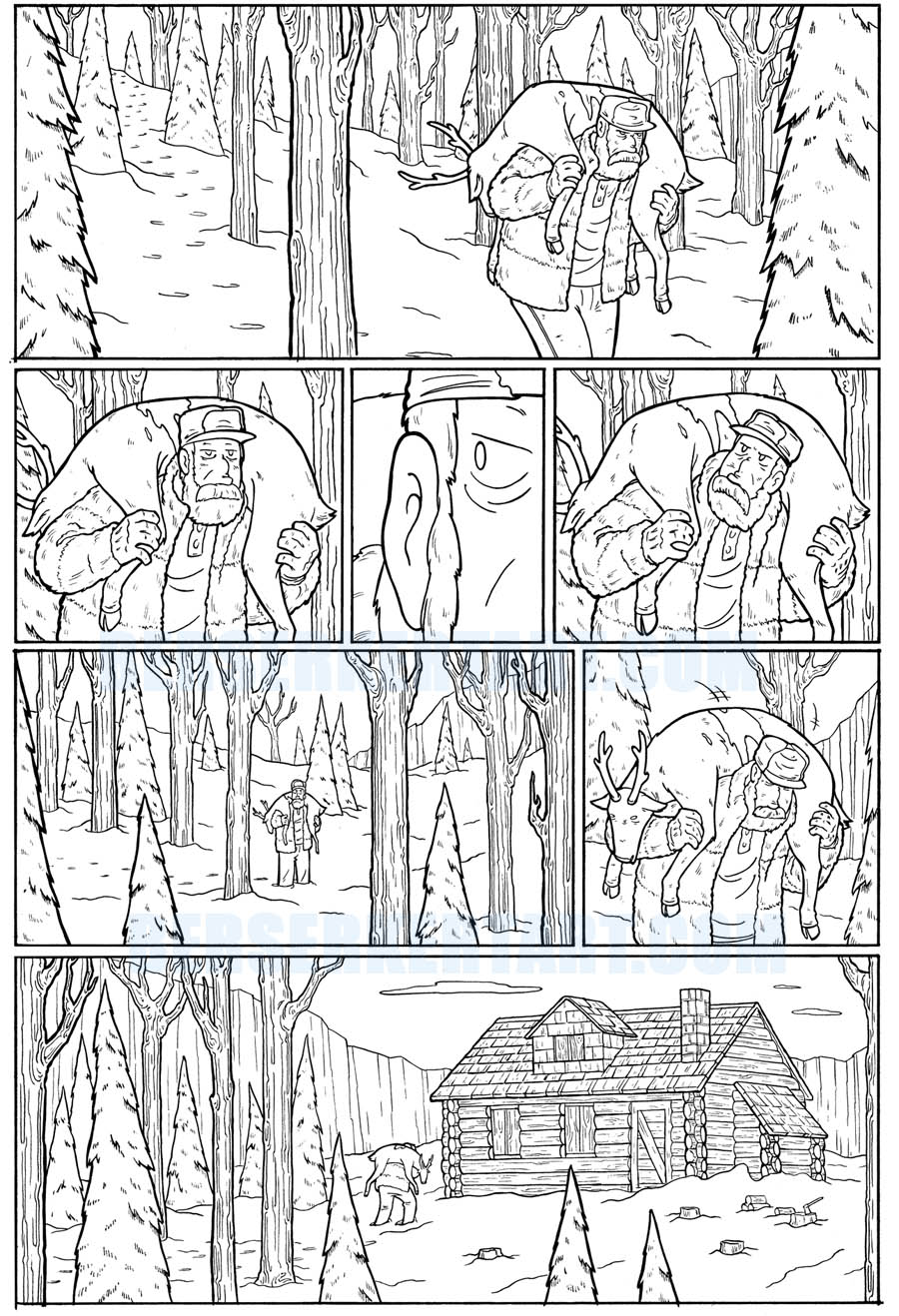
Oh! and here it is in color, via the work of Andy Brown.
A fun challenge...but make no mistake, plenty of action in this story as well. To that end, next time I'll go over a bit of how I illustrated some of the action scenes...
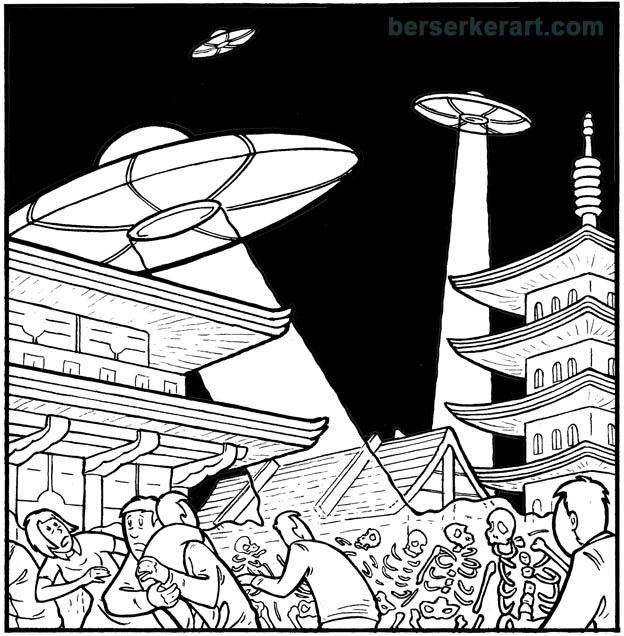
Til then, you're local comic shop can get the book this story is in (along with some other great work by some great storytellers)
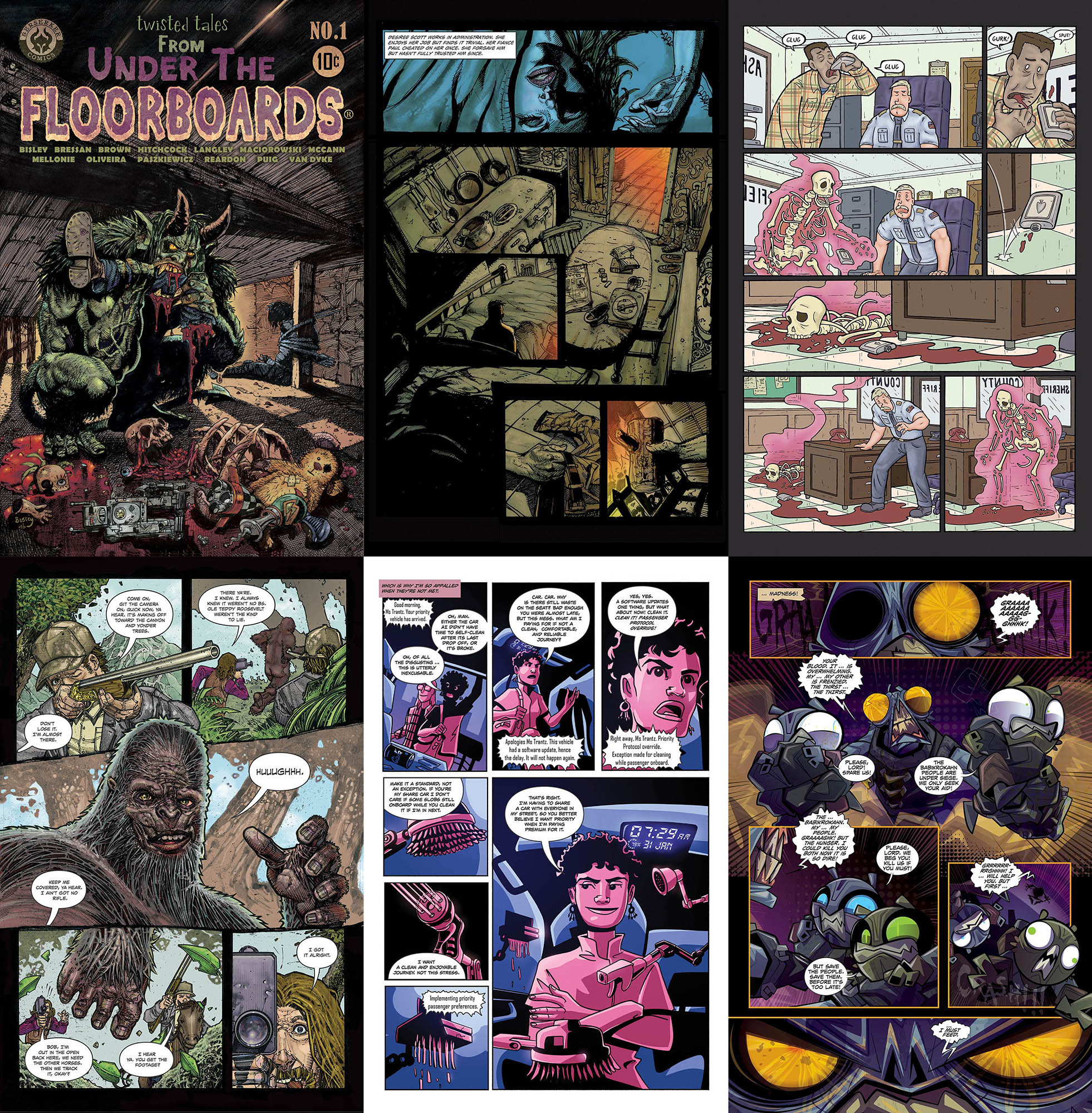
This link'll help if they have questions
Or you can get it straight through Berserker. Fear not, my incompetent ass is not in charge of shipping. They had me draw a story and am not in the position to screw anything up after that.
https://www.kickstarter.com/projects/berserkercomics/under-the-floorboards-anthology-graphic-novel?fbclid=IwAR0K-nmUOZ8vCVOvVoNUY7ZocTTITQucZz0G776xErF4nBabn2SbcfwC8S0
anyways...
As always, homebase is here
https://www.arseniclullabies.com
and you can sign up for email updates and sneak previews here
https://arseniclullabies.com/phplist/?p=subscribe


Comics are different to other forms of storytelling for sure. I think you did a great job of meeting the requirements of the script without resorting to any words.